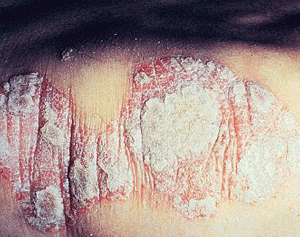-iasis
(Greek > Latin: suffix; a process; a diseased condition)
In extreme cases, parasitic otitides cause symptoms, such as loss of appetite, wasting away, and fits.
2. A chronic dermatosis of unknown origin, with erythematous, papular, and scaling lesions appearing in persistent and often enlarging plaques.
3. Any of a group of slowly evolving erythrodermas having common characteristics of scaling, resistance to treatment, and chronicity. The group includes acute and chronic lichenoid pityriasis and large and small plaque parapsoriasis.
4. A heterogenous group of skin disorders including pityriasis lichenoides and small and large plaque variants.
2. A chronic skin disease characterized by circumscribed red patches covered with white scales.
3. A noncontagious inflammatory skin disease characterized by recurring reddish patches covered with silvery scales.
4. The cause of the disease is unknown, but a genetic predisposition is apparent.
5. Etymology: first recorded in 1684, from Late Latin psoriasis, "mange, scurvy", which came from Greek psoriasis, "being itchy"; from psorian, "to have the itch"; from psora, "itch"; related to psen "to rub".
A medical "clarification" for greater "understanding"
A common chronic, squamous dermatosis, marked by exacerbations and remissions and having a polygenic inheritance pattern. The most distinctive histological findings in well developed psoriasis are Munro microabscesses and spongiform pustules.
It is characterised clinically by the presence of rounded, circumscribed, erythematous, dry scaling patches of various sizes, covered by greyish white or silvery white, umbilicated and lamellar scales, which have a predilection for the extensor surfaces, nails, scalp, genitalia and lumbosacral region.
Central clearing and coalescence of the lesions produce a wide variety of clinical configurations, including annular, or circinate, discoid or nummular, figurate and gyrate arrangements.

![]() Here is much more information about psoriasis.
Here is much more information about psoriasis.
2. A swollen state of the genital organs, a disease in which the bones near the temples are elongated so as to be like a Satyr's horns.
There are some psychiatrists who now use the term, hypersexuality, which describes a desire for human sexual behavior at levels high enough to be considered clinically significant.
2. The disease characterized by the formation of salivary calculi.
Symptoms depend on the site of the calculus or calculi and whether infections, sometimes recurrent, are concerned. In the submandibular salivary gland, the site of 90 percent of such cases, large calculi are likely to obstruct the duct and result in swelling of the gland while eating. Also, ptyalolithotomy.


